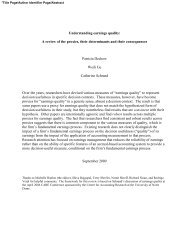Nintendo's “Revolution” - MIT Sloan School of Management
Nintendo's “Revolution” - MIT Sloan School of Management
Nintendo's “Revolution” - MIT Sloan School of Management
Create successful ePaper yourself
Turn your PDF publications into a flip-book with our unique Google optimized e-Paper software.
NINTENDO’S “REVOLUTION”<br />
Sangbeom Kim, Ian Lamont, Hiroshi Ogasawara, Mansoo Park, Hiroaki Takaoka<br />
would help the Revolution launch with a back catalog, and would also appeal to loyal Nintendo<br />
customers who had invested in GameCube games. 58<br />
This new approach to console design was extended to the controller. Designer Kenichiro Ashida<br />
explained the evolution <strong>of</strong> his thinking about the controller:<br />
I felt strongly that this would be a console that I, too, could enjoy. More specifically, I felt that it<br />
might be time to reconsider the entire game-play style <strong>of</strong> grasping the controller with two hands,<br />
sitting glued to the TV until morning. Of course, I’m not rejecting that intense style <strong>of</strong> play, but I<br />
did feel that taking the whole idea <strong>of</strong> grasping the controller with two hands back to the drawing<br />
board <strong>of</strong>fered a glimpse <strong>of</strong> the future. 59<br />
The rest <strong>of</strong> the design team, right up to the CEO, was supportive <strong>of</strong> the new approach. Iwata, as<br />
someone who had started developing computer games on a programmable calculator when he was a<br />
teenager, appreciated evolutionary steps in game-play and hardware design, and encouraged the team<br />
to think creatively. However, there were limits to how far the team would go, as Miyamoto noted:<br />
This was good in the sense that it allowed us to consider ideas such as not using hands at all, or<br />
even putting the controller on your head. Of course, going too far in that direction would just lead<br />
to something that is different just for the sake <strong>of</strong> being different. An eccentric design like that<br />
might work well for some games, but could never be used as a standard, making it a difficult<br />
choice for a console’s primary controller. So we wanted to come up with a bold and daring design<br />
that would be within the bounds <strong>of</strong> reason. 60<br />
Takeda formed a special controller development team. He believed that the controller was not just a<br />
console peripheral, but also an intermediary between man and machine, and even an extension <strong>of</strong> the<br />
human body. As the controller would be the most frequently used part <strong>of</strong> the console, the controller<br />
development team aimed to create a simple and comfortable controller, which everyone would like to<br />
touch. 61<br />
The team created a series <strong>of</strong> prototypes. Early designs were molded out <strong>of</strong> clay or Styr<strong>of</strong>oam. The<br />
more promising designs were turned into plastic prototypes with working buttons. One prototype had<br />
a touch panel like the Nintendo DS. Another featured a mouse-like pointing device. There was also a<br />
track pad, and even a hat-like controller that allowed gamers to play without using their hands. The<br />
team constantly experimented with the designs, but decided a pointer-based controller was the best<br />
way to go.<br />
58 “Wii Remote: Taking Control Back To The Drawing Board,” Wii.nintendo-europe.com, December 2006. Accessed from http://wii.nintendo-<br />
europe.com/164.html in December 2010.<br />
59 Ibid.<br />
60 Ibid.<br />
61 Kouji Sasaki, “Interview with Satoru Iwata,” Nikkei Business, November 27, 2006.<br />
October 18, 2011 14
















